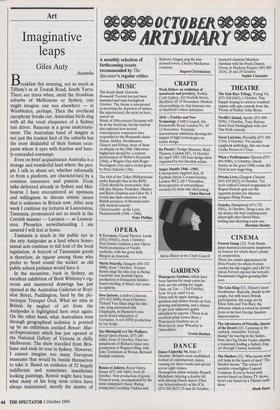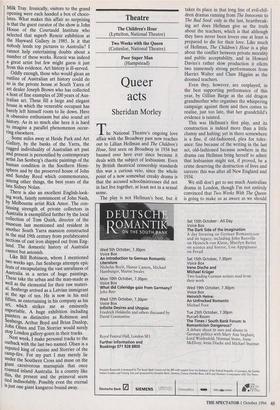Art
Imaginative leaps
Giles Auty
Breakfast this morning, not so much at Tiffany's as at Toorak Road, South Yarra. There are times when, amid the frondiose suburbs of Melbourne or Sydney, one might imagine one was elsewhere — in Wimbledon, perhaps. Then the overhead cacophony breaks out. Australian birds sing with all the vocal eloquence of a Sydney taxi driver. Raucous is a gross understate- ment. The Australian band of magpie is not just the loudest bird of the suburbs but the most disdainful of their human occu- pants whom it eyes with fearless and bare- ly-concealed contempt, Even on brief acquaintance Australia is a strange and wonderful land where the peo- ple I talk to about art, whether informally or from a platform, are characterised by a common innocence and passion. From talks delivered already in Sydney and Mel- bourne I have encountered an openness and willingness to discuss artistic issues that is unknown in Britain now. After next week I continue my lectures at Launceston, Tasmania, pronounced not so much in the Cornish manner — Larnson — as Launcis- ston. Phonetics notwithstanding I am assured I will feel at home.
Tasmania is much in the public eye in the arty Antipodes as a land where homo- sexual acts continue to fall foul of the local legislation. A boycott of Tasmanian goods is therefore, de rigueur among those who prefer to 'bowl round the wicket' as old public school parlance would have it.
In the meantime, back in Sydney, an excellent exhibition of Brett Whiteley's vig- orous and mannered drawings has just opened at the Australian Galleries at Royl- ston Street, Paddington, hard by the pic- turesque Trumper Oval. What we miss in Britain by neglect of art from the Antipodes is highlighted here once again. On the other hand, what Australians miss through geographical isolation is pointed up by an exhibition entitled Renoir:• Mas- ter/Impressionist which has just opened at the National Gallery of Victoria in chilly Melbourne. The show travelled from Bris- bane and ends its tour in Sydney. However, I cannot imagine too many European museums that would be beside themselves to take it. Based on evidence of 52 largely indifferent and sometimes inauthentic looking paintings, Renoir might have been what many of his long term critics have always maintained: merely the master of Australia Milk Tray. Ironically, visitors to the grand opening were each handed a box of choco- lates. What makes this affair so surprising is that the guest curator of the show is John House of the Courtauld Institute who selected that superb Renoir exhibition at the Hayward Gallery in 1985. Is it that nobody lends top pictures to Australia? I cannot help entertaining doubts about a number of these works. Renoir was indeed a great artist but few might guess it just from this evidence. Art history is ill-served.
Oddly enough, those who would glean an outline of Australian art history could do so in the private house at South Yarra of art dealer Joseph Brown who has collected a host of fine examples of 200 years of Aus- tralian art. These fill a large and elegant house in which the venerable occupant has barely left himself room to lie down. Here is obsessive enthusiasm but also sound art history. As in so much else here it is hard to imagine a parallel phenomenon occur- ring elsewhere.
Some miles away at Heide Park and Art Gallery, by the banks of the Yarra, the rugged individuality of Australian art past and present is personified by contemporary artist Jan Senberg's chaotic paintings of the human condition in the Southern Hemi- sphere and by the preserved house of John and Sunday Reed which commemorates, among other things, the best years of the late Sidney Nolan. There is also an excellent English-look- ing work, faintly reminiscent of John Nash, by Melbourne artist Rick Amor. The con- tinuing strength of private collectors in Australia is exemplified further by the local collection of Tom Quirk, director of the museum last mentioned and resident in another South Yarra mansion constructed in the mid 19th century from prefabricated sections of cast iron shipped out from Eng- land. The domestic history of Australia cannot but astonish.
Like Bill Robinson, whom I mentioned two weeks ago, Jan Senbergs attempts epic feats of encapsulating the vast unruliness of Australia in a series of huge paintings. These take the urban and the man-made as well as the elemental for their raw materi- al. Senbergs arrived as a Latvian immigrant at the age of ten. He is now in his mid fifties, as entertaining in his company as his art, which strikes me as eminently exportable. A huge exhibition including painters as distinctive as Robinson and Senbergs, Arthur Boyd and Brian Dunlop, John Olsen and Tim Storrier would surely Stop London gallery-goers in their tracks. Next week, I make personal tracks to the outback with the last two named. Olsen is a reputed king of cuisine and Stonier of the camp-fire. For my part I may merely lie under the Southern Cross and muse on the giant carnivorous marsupials that once roamed inland Australia. In a country like this, the present and the primeval seem tied indissolubly. Possibly even the eternal is just one giant kangaroo bound away.



























































 Previous page
Previous page